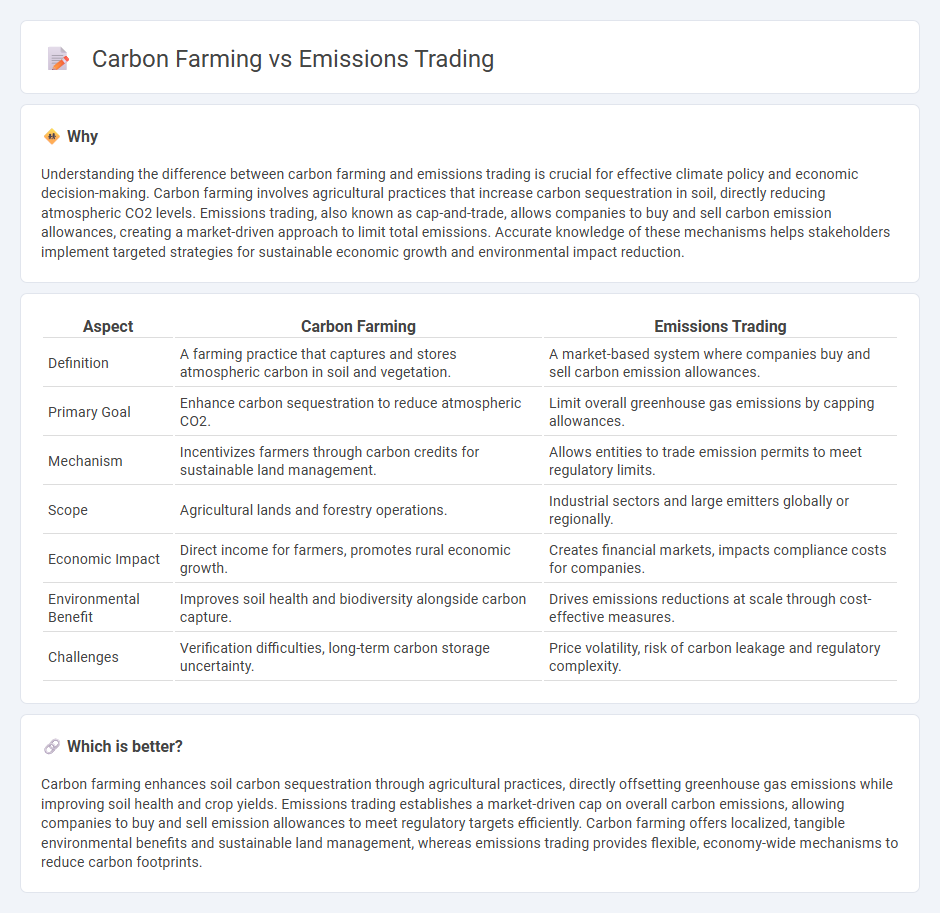
Carbon farming captures atmospheric CO2 through agricultural practices like cover cropping and agroforestry, enhancing soil carbon storage and promoting sustainable land use. Emissions trading, also known as cap-and-trade, sets a market-based limit on total emissions, allowing companies to buy and sell allowances to meet regulatory targets efficiently. Explore the comparative impacts and benefits of carbon farming versus emissions trading to understand their roles in combating climate change.
Why it is important
Understanding the difference between carbon farming and emissions trading is crucial for effective climate policy and economic decision-making. Carbon farming involves agricultural practices that increase carbon sequestration in soil, directly reducing atmospheric CO2 levels. Emissions trading, also known as cap-and-trade, allows companies to buy and sell carbon emission allowances, creating a market-driven approach to limit total emissions. Accurate knowledge of these mechanisms helps stakeholders implement targeted strategies for sustainable economic growth and environmental impact reduction.
Comparison Table
| Aspect | Carbon Farming | Emissions Trading |
|---|---|---|
| Definition | A farming practice that captures and stores atmospheric carbon in soil and vegetation. | A market-based system where companies buy and sell carbon emission allowances. |
| Primary Goal | Enhance carbon sequestration to reduce atmospheric CO2. | Limit overall greenhouse gas emissions by capping allowances. |
| Mechanism | Incentivizes farmers through carbon credits for sustainable land management. | Allows entities to trade emission permits to meet regulatory limits. |
| Scope | Agricultural lands and forestry operations. | Industrial sectors and large emitters globally or regionally. |
| Economic Impact | Direct income for farmers, promotes rural economic growth. | Creates financial markets, impacts compliance costs for companies. |
| Environmental Benefit | Improves soil health and biodiversity alongside carbon capture. | Drives emissions reductions at scale through cost-effective measures. |
| Challenges | Verification difficulties, long-term carbon storage uncertainty. | Price volatility, risk of carbon leakage and regulatory complexity. |
Which is better?
Carbon farming enhances soil carbon sequestration through agricultural practices, directly offsetting greenhouse gas emissions while improving soil health and crop yields. Emissions trading establishes a market-driven cap on overall carbon emissions, allowing companies to buy and sell emission allowances to meet regulatory targets efficiently. Carbon farming offers localized, tangible environmental benefits and sustainable land management, whereas emissions trading provides flexible, economy-wide mechanisms to reduce carbon footprints.
Connection
Carbon farming enhances soil carbon sequestration, creating quantifiable carbon credits that can be traded in emissions trading markets. These credits provide economic incentives for farmers to adopt sustainable practices while enabling corporations to offset their greenhouse gas emissions. This synergy between carbon farming and emissions trading supports a market-driven approach to reducing atmospheric carbon and promoting sustainable economic growth.
Key Terms
**Emissions Trading:**
Emissions trading, also known as cap-and-trade, allocates a maximum limit on greenhouse gas emissions and allows companies to buy or sell emission allowances within that cap, promoting cost-effective reduction strategies. This market-based approach incentivizes reduction in carbon dioxide and other greenhouse gases by assigning a measurable economic value to emission permits. Explore in-depth mechanisms and benefits of emissions trading to understand its role in climate change mitigation.
Cap-and-trade
Cap-and-trade systems set a maximum limit on greenhouse gas emissions, allowing companies to buy and sell emission permits to stay under the cap, promoting cost-effective reductions. Carbon farming involves agricultural practices that increase carbon sequestration in soil and vegetation, generating carbon credits that can be sold in voluntary or compliance markets. Explore in-depth how cap-and-trade and carbon farming interact to drive sustainable emissions management.
Allowances
Emissions trading systems allocate carbon allowances that enable companies to buy or sell the right to emit specific amounts of greenhouse gases, fostering a market-driven approach to pollution reduction. Carbon farming generates credits by implementing agricultural practices that sequester carbon, which can then be sold as offsets within voluntary or compliance carbon markets. Explore how allowances and credits interrelate to optimize climate strategies by learning more about emissions trading and carbon farming.
Source and External Links
Emissions trading - Emissions trading, also known as cap and trade, is a market-based approach that sets a limit (cap) on the total amount of certain pollutants allowed and lets polluters buy and sell permits to emit those pollutants, creating economic incentives for reducing emissions.
How do emissions trading systems work? - In an emissions trading system, a government sets a cap on emissions, issues permits (allowances) equal to the cap, and allows firms to trade these permits--providing flexibility and incentivizing cost-effective emissions reductions.
EU Emissions Trading System (EU ETS) - The EU ETS, launched in 2005, is the world's first international carbon market, covering key sectors and gases, and progressively lowering the cap to drive emission reductions while applying the polluter pays principle and ensuring market transparency.
 dowidth.com
dowidth.com